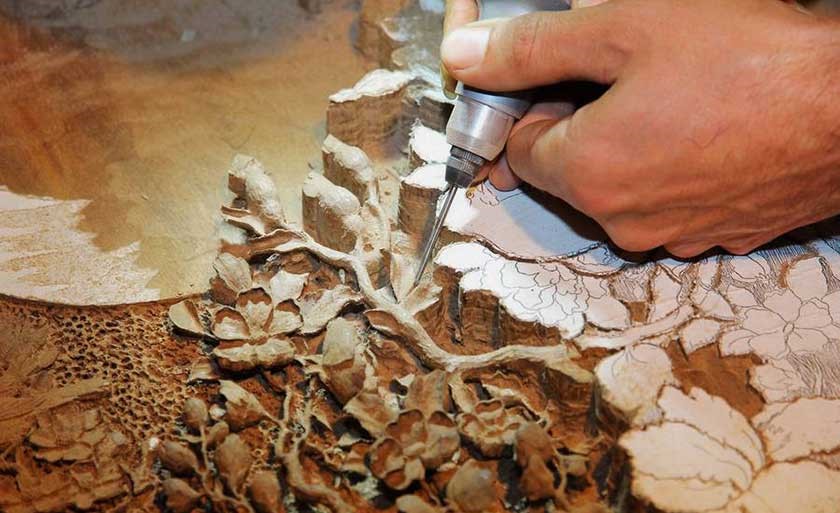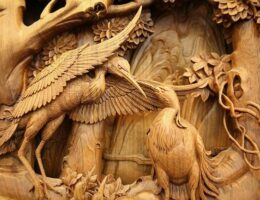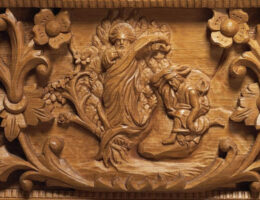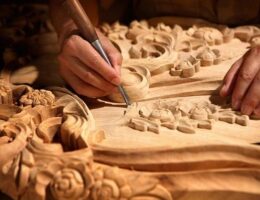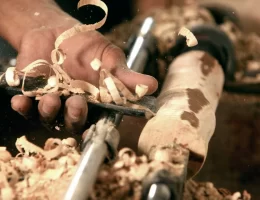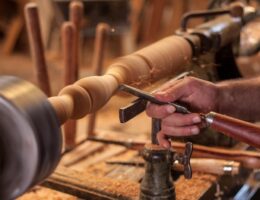IRAN ART EXHIBITION: INTRODUCING ART OF WOOD CARVING AND ITS HISTORY
The art of creating embossed designs on the surface of wood via cutting and removing the design background by metal tools is called wood carving. Wood carving is one of the worthiest Iranian traditional arts particularly from the time of Arabs domination on Iran. Some wood carving designs are also observed in Persepolis works. There have been five to ten wood carving designs based on geometric designs, parallel grooves, arabesque, khtayy and tholth calligraphies in Iranian style in the Islamic middle period. In the Safavid Period, wood carving like other Iranian arts was accomplished leading to creation of lots of masterpieces. There are some mosques in Isfahan from the Safavid Dynasty the doors of which have remained safe and untouched.
In this artistic style the craftsman transfers the design in the form of real leather of charcoal powder to the surface of the wood then creates the peripheral lines around the design by means of tools like half round chisel and flat-head chisel … and then carves it by removing the background. The depth of the carving depends on the application of the object which is being made. For example, if the carving is meant to be a decorative object, the thickness will be a few millimeters but if it is a wooden mould for calico printing the depth can be up to five cm. Carving is usually done on kinds of wood which are strong and have no knots such as walnut, pear and ebony trees and some kinds of forest trees. Pear tree wood is used for fine works, but for larger works or wooden statues, walnut-tree wood is used which has been sunk in oil because the oil is absorbed by wood, making its surface softer for carving. The wood on which carving is done is firmly fixed by a clamp so that the chisel may move on it very easily. Different chisels are used for different parts of the work-piece, so that the wooden design might be as similar to the original as possible.
Having carved the background and having reached the desirable thickness, the tiny carving operations are done on the embossed parts by means of tip of a chisel or a sharp knife used for delicate works and then the work-piece is polished by sand stone. This action is traditionally called multilevel work. Finally, the entire work surface is glazed by oil or a coat of polyester so that the wood may not crack by the lapse of time and may resist against moisture.
IRAN ART EXHIBITION: All Iranian handicrafts come from within the people. In fact, no person or persons played a role in inventing this eye-catching art(woodcarving), but ordinary people began to engrave and carve on wood. Undoubtedly, wood is one of the most abundant materials in human history that has always existed in nature. One of the brilliant handicrafts in Iran, like the other kinds of ancient crafts which is a combination of art and patience, is Persian Woodcarving. Its artisans create highly talented and valuable consumer goods from a cheap and great deal of initial materials. Persian Woodcarving involves the carving of wood based on precise designs. each carved piece of wood is a good sample of its creator’s feeling, perception, and opinion.
The history of wood carving
The history of Persian Woodcarving, like the other arts and crafts which was born and grown among scattered populations whose founders were ordinary people, is not so clear.
Actually, it cannot be said from which era this art industry matured. But certainly, wood as the most plentiful material in nature is the first thing that drew man’s consideration to it and was used for making consumer goods. Based on the available documents, wood carving in Iran goes back to the Achaemenid and Sassanid times. In the northeast of Persepolis, some clay inscriptions have been found the translation some of which indicate wage-paying to the masters of inlaying art.
It was created of poplar wood in the Omar En Leice Safari period. It is decorated with very beautiful polygon designs out of walnut wood. After this, the other work which is the upper part of a door carved out of the deal and belongs to the fourth century A.H. should be pointed. It is delicately carved with Kufic scripts of 3 centimetres thick.

In Safavid period
In the Safavid period, attending the eye-catching and noticeable expansion of religious buildings and royal palaces, a great number of artists went to the center of the country, Isfahan_where most of the above-mentioned buildings were constructed.
One of the consequences of their gathering in one place that caused the creation of marvellous and worthy of everlasting works was the exchange of their skills and experiments. After the attack of Afghans on Iran, political turbulences made every constructive performance limited.
At that time, Abadeh a suburb of Shiraz was the only center of woodcarvers. Except for that place, there were no signs of woodcarvers and wood carving through all the country.
IRAN ART EXHIBITION: Among a few remaining wood carvers, the two head artisans, Mr. Ahmad Saniee and Mr. Ali Mokhtari came to Tehran and while performing their art gravely, they trained some students to revive and keep their ancestors’ art and industry.
The establishment of the handicraft organization of Iran as a guardian for traditional and domestic industries became a means for supplying artists and prevented wood carving to die.
Now, Abadeh in the province of Shiraz and Golpaygan in the province of Isfahan Province are the main centers of Persian Woodcarving. Besides, there is a group engaged in wood carving in Bushehr.
In the other parts of the country, wood carvings are done separately, too. Iranian woodcarvers use different kinds of woods available in the country easily and cheaply. With laudable patience, they use simple tools such as a few metal chisels and to manifest their works with Islamic and Iranian values in the shape of Kufic scripts, Arabesques, Cathays, flowers, birds, etc.
Important woodcarvings in the country can be found in mosques, castles and ancient buildings. Some of the Iranian inlaid works are preserved in museums inside or outside Iran.
The usual images are rose leaves and drawings of birds and animals. Latticed woodwork is another art, which is made by hand. Persian Woodcarving
